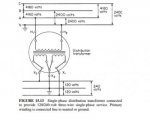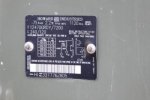Sean.Day72
Member
- Location
- Florida
Was looking through some design and had a questions.
Supposed there is a 3 Wire (7200V) medium voltage feed going into a Outdoor 3 Way pad mounted switchgear (S&C 321). 3 Phases come out of the gear and head north into a 3 phase primary junction Primary Junction Cabinet (PJC). Phase A heads west out of the PJC to feed residential transformers (3 wire, 120/240), Phase B head East to do the same, Phase C continuous north to do the same. First question, the transformers feeding the houses out of each phase should be connected in parallel correct? There are four transformers servicing 12 houses on each road, each road fed by one phase.
The primary side wire is 1/0 aluminum with a full concentric neutral.The transformers on the rode are looped together. When the cable comes into the transformer they braid together the neutral and connect into a dead break connector right? Where should the neutral be grounded on the primary side? At the last transformer in the line? At the PJC? Neither it somehow makes it way all the way back through multiple switches to the transformer (source). This is a large subdivision so I'm having trouble visualizing the circuit. I attached photo for reference.
Supposed there is a 3 Wire (7200V) medium voltage feed going into a Outdoor 3 Way pad mounted switchgear (S&C 321). 3 Phases come out of the gear and head north into a 3 phase primary junction Primary Junction Cabinet (PJC). Phase A heads west out of the PJC to feed residential transformers (3 wire, 120/240), Phase B head East to do the same, Phase C continuous north to do the same. First question, the transformers feeding the houses out of each phase should be connected in parallel correct? There are four transformers servicing 12 houses on each road, each road fed by one phase.
The primary side wire is 1/0 aluminum with a full concentric neutral.The transformers on the rode are looped together. When the cable comes into the transformer they braid together the neutral and connect into a dead break connector right? Where should the neutral be grounded on the primary side? At the last transformer in the line? At the PJC? Neither it somehow makes it way all the way back through multiple switches to the transformer (source). This is a large subdivision so I'm having trouble visualizing the circuit. I attached photo for reference.


